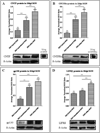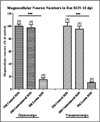Neuronal activity and axonal sprouting differentially regulate CNTF and CNTF receptor complex in the rat supraoptic nucleus
- PMID: 22037350
- PMCID: PMC3268916
- DOI: 10.1016/j.expneurol.2011.10.009
Neuronal activity and axonal sprouting differentially regulate CNTF and CNTF receptor complex in the rat supraoptic nucleus
Abstract
We demonstrated previously that the hypothalamic supraoptic nucleus (SON) undergoes a robust axonal sprouting response following unilateral transection of the hypothalamo-neurohypophysial tract. Concomitant with this response is an increase in ciliary neurotrophic factor (CNTF) and CNTF receptor alpha (CNTFRα) expression in the contralateral non-uninjured SON from which the axonal outgrowth occurs. While these findings suggest that CNTF may act as a growth factor in support of neuronal plasticity in the SON, it remained to be determined if the observed increase in neurotrophin expression was related to the sprouting response per se or more generally to the increased neurosecretory activity associated with the post-lesion response. Therefore we used immunocytochemistry and Western blot analysis to examine the expression of CNTF and the components of the CNTF receptor complex in sprouting versus osmotically-stimulated SON. Western blot analysis revealed a significant increase in CNTF, CNTFRα, and gp130, but not LIFRß, protein levels in the sprouting SON at 10days post lesion in the absence of neuronal loss. In contrast, osmotic stimulation of neurosecretory activity in the absence of injury resulted in a significant decrease in CNTF protein levels with no change in CNTFRα, gp130, or LIFRß protein levels. Immunocytochemical analysis further demonstrated gp130 localization on magnocellular neurons and astrocytes while the LIFRß receptor was found only on astrocytes in the SON. These results are consistent with the hypothesis that increased CNTF and CNTFR complex in the sprouting, metabolically active SON are related directly to the sprouting response and not the increase in neurosecretory activity.
Copyright © 2011 Elsevier Inc. All rights reserved.
Figures






References
-
- Albrecht PJ, Dahl JP, Stoltzfus OK, Levenson R, Levison SW. Ciliary neurotrophic factor activates spinal cord astrocytes, stimulating their production and release of fibroblast growth factor-2, to increase motor neuron survival. Exp Neurol. 2002;173:46–62. - PubMed
-
- Aliaga E, Arancibia S, Givalois L, Tapia-Arancibia L. Osmotic stress increases brain-derived neurotrophic factor messenger RNA expression in the hypothalamic supraoptic nucleus with differential regulation of its transcripts. Relation to arginine-vasopressin content. Neuroscience. 2002;112:841–850. - PubMed
-
- Arancibia S, Lecomte A, Silhol M, Aliaga E, Tapia-Arancibia L. In vivo brain-derived neurotrophic factor release and tyrosine kinase B receptor expression in the supraoptic nucleus after osmotic stress stimulus in rats. Neuroscience. 2007;146:864–873. - PubMed
-
- Armstrong WE, Gallagher MJ, Sladek CD. Noradrenergic stimulation of supraoptic neuronal activity and vasopressin release in vitro: mediation by an alpha 1-receptor. Brain Res. 1986;365:192–197. - PubMed
Publication types
MeSH terms
Substances
Grants and funding
LinkOut - more resources
Full Text Sources
Other Literature Sources

